
Here’s the full version of your monthly magazine: January’s Tudor Life magazine is 76 pages long and is themed with information about the Grey family.
[Read More...]
Here’s the full version of your monthly magazine: January’s Tudor Life magazine is 76 pages long and is themed with information about the Grey family.
[Read More...]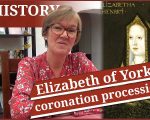
On this day in Tudor history, Saturday 24th November 1487, the coronation procession of Elizabeth of York, queen consort of King Henry VII, the first Tudor monarch, took place in London.
Elizabeth of York’s coronation was scheduled for the next day. She had become queen in January 1486, but her coronation had been postponed due to pregnancy and trouble with the Cornish rebels and Perkin Warbeck. Finally, Henry VII’s wife and the mother of little Prince Arthur could be crowned queen.
Find out all about her coronation procession, what Elizabeth wore, who was involved and what happened, in today’s talk.
[Read More...]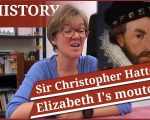
On this day in Tudor history, 20th November 1591, Sir Christopher Hatton, Elizabeth I’s Lord Chancellor and favourite, died aged fifty-one. He was such a favourite of Queen Elizabeth I that he had a dazzling career and was constantly at her side.
Find out more about Sir Christopher Hatton, his career and accomplishments, his patronage of learned men and explorers, and his special relationship with Elizabeth I, in today’s talk.
[Read More...]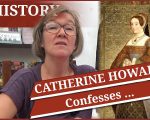
On this day in Tudor history, Monday 7th November 1541, Thomas Cranmer, Archbishop of Canterbury, visited Catherine Howard, fifth wife of King Henry VIII, in her chambers at Hampton Court Palace.
Catherine had been confined to her chambers and Archbishop Cranmer’s job was to get the now hysterical queen to talk, to confess. He visited her a few times over a period of 24 hours and finally got a confession from her. But what did Catherine have to say?
Find out all about Catherine Howard’s confessions, and there were several, in today’s talk.
[Read More...]
June’s 76 Page FULL COLOUR Tudor Life magazine is focused on queenship during the Tudor period. It’s packed with interesting facts and articles about all of the Tudor queens and as always it’s a really great quality publication in full colour too! We know you’ll enjoy it.
[Read More...]
May’s Tudor Life magazine is focused on the Boleyn Family, including the infamous Anne Boleyn, but also her brother George Boleyn, father Thomas Boleyn, sister Mary Boleyn and even wider. As always it’s packed from start to finish with interesting facts, articles and stunning photos. We’ve even got an exclusive “behind the scenes” photo montage from Hever Castle. Not to be missed …
[Read More...]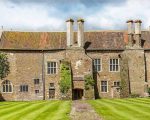
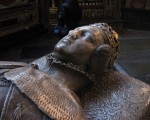
19th November:
1563 – Robert Sidney, 1st Earl of Leicester, courtier, patron of the arts and poet, was born at Penshurst in Kent. Sidney was the second son of Sir Henry Sidney and his wife, Mary (née Dudley), daughter of John Dudley, Duke of Northumberland. It was discovered that Robert was a poet, like his more famous brother Philip, when his notebook came to light in the library of Warwick Castle in the 1960s. The notebook contained a collection of over sixty sonnets, pastorals, songs and shorter pieces written in the 1590s.
1564 – Death of Lord John Grey, youngest son of Thomas Grey, 2nd Marquis of Dorset and courtier. Grey was arrested with his brothers, Thomas and Henry (Duke of Suffolk and father of Lady Jane Grey), in 1554 for their involvement in Wyatt’s Rebellion. Thomas and Henry were executed, and although John was condemned to death, he was released and pardoned due to the intercession of his wife, Mary, sister of Anthony Browne, Viscount Montagu.
1566 – Death of Reynold Corbet, member of Parliament and judge. He was buried at Stoke upon Tern in Shropshire. Corbet’s offices included recorder of Shrewsbury, Justice of the Peace for Shropshire, a member of the Council in the Marches and Puisne Justice of the Queen’s Bench.
1584 – Death of William Bendlowes, member of Parliament, Serjeant-at-Law and Law Reporter. He was buried at Great Bardfield in Essex, where his monumental brass can still be seen today. Bendlowes reported on court cases from the period 1534-1579.
1587 – Death of Henry Vaux, poet, Catholic recusant and priest harbourer, of consumption at Great Ashby, the home of his sister, Eleanor Brooksby. Vaux was sent to Marshalsea prison after being arrested in November 1586 for offering accommodation and assistance to Catholic priests. He was released in May 1587 due to ill health.
1590 – Death of Thomas Godwin, physician and Bishop of Bath and Wells, at Wokingham in Berkshire, his birthplace. He had retired there due to ill health, and was buried in the local church. Elizabeth I chose Godwin as one of her Lent preachers, and he served in that post for eighteen years.
1604 – Death of Richard Edes, Dean of Worcester, royal chaplain and court preacher, at Worcester. He was buried in Worcester Cathedral. Edes was a royal chaplain to Elizabeth I and James I, and had just been appointed to work on a new version of the English Bible when he died.
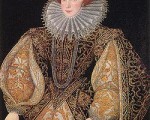
1514 – Mary Tudor, sister of Henry VIII, was crowned Queen of France. She had married King Louis XII at Abbeville on the 9th October 1514. The marriage was rather short-lived, as Louis died on the 1st January 1515, and Mary went on to marry Charles Brandon, Duke of Suffolk.
1520 – Death of Sir Robert Poyntz, courtier, landowner and Vice-Chamberlain and Chancellor of the Household to Queen Catherine of Aragon. He was around seventy when he died.
1530 – Death of Sir John More, lawyer, judge and father of Sir Thomas More. More served as Serjeant-at-Law, Justice of Assize, Justice of the Common Pleas, and also served on the King’s Bench from 1520 until his death.
1605 – Guy Fawkes was caught with thirty-six barrels of gunpowder in the cellars beneath Westminster. The idea was to blow up the House of Lords at the opening of Parliament on the 5th November, and to assassinate King James I.
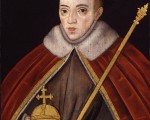
29th October:
1532 – Henry VIII accompanied Francis I to the border between English Calais and France to bid farewell to him.
1586 – Four days after a commission had found Mary, Queen of Scots guilty of conspiring to assassinate Elizabeth I, Parliament met to discuss Mary’s fate. They decided that they should petition the Queen for Mary’s execution.
1605 – Death of George Clifford, 3rd Earl of Cumberland, courtier and naval commander, at the duchy house, near the Savoy in London. He was buried in the family vault in Holy Trinity Church, Skipton, near Skipton Castle. Clifford was Elizabeth I’s second champion. He commanded a ship in the Anglo-Spanish War, and is known for capturing Fort San Felipe del Morro in San Juan, Puerto Rico, in 1598. Elizabeth I nicknamed him her “rogue”.
1618 – Sir Walter Ralegh (Raleigh), courtier, explorer, author and soldier, was executed at Westminster. Ralegh had originally been found guilty of treason and sentenced to death in 1603, after being implicated in the Main Plot against James I, but the King spared his life. In 1618, the death sentence was reinstated after he incurred the wrath of Spain for storming San Thomé and killing the Spanish governor.
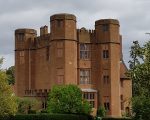
After another yummy breakfast the Arden Hotel’s veggie cooked breakfast is delicious, by the way – we headed off to spend the morning at Kenilworth Castle.
Kenilworth Castle dates back to the 12th century, but for us Tudor history lovers it’s the link with Robert Dudley, Earl of Leicester, that gets us excited. Leicester, who was of course Elizabeth I’s good friend and favourite, and, I believe, the love of her life, was granted the castle in 1563. In 1575, the Queen visited Kenilworth Castle for 19 days, the longest visit she made to any courtier, and Leicester made many changes to the castle in anticipation of her visit, including creating a chase, building a gatehouse and bridge over the mere, building a four-storey block of state apartments, and creating a beautiful privy garden. He also commissioned special entertainments for the queen in a last-ditch attempt to woo her.
[Read More...]
In this week’s Claire Chats, I explain the situation with Bosworth Battlefield, what it’s all about, what happened at the planning meeting and what we can about it.
Please so sign the petition at https://www.change.org/p/planning-hinckley-bosworth-gov-uk-stop-building-a-high-test-track-on-bosworth-battlefield
[Read More...]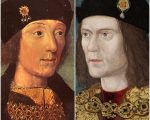
Today is the anniversary of the Battle of Bosworth on 22nd August 1485. This battle was, of course, the start of the Tudor dynasty because it was at this battle that the forces of Henry Tudor, who had returned from exile to claim the throne of England, defeated those of Richard III. Richard was killed during the battle and Henry was crowned King Henry VII. He ruled until his death, by natural causes, on 21st April 1509.
You can read more about the battle in our article The Battle of Bosworth – 22 August 1485, and you can also find out more about the battle and the two kings involved with the following resources:
[Read More...]
MedievalCourses.com are commemorating the anniversary of the Battle of Bosworth this week by offering 25% off all of their online history courses from today until the end of 24th August 2018.
All you have to do is choose your course (or courses!) at https://medievalcourses.com/overview/ and use coupon code BOS at checkout. You can use the code on as many courses as you like and what’s great is that the courses don’t have a set start or end date so you can buy courses now and then start them when it’s convenient for you.
[Read More...]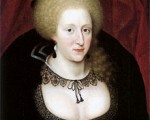
20th August:
1509 – Birth of Sir William Stanford (Staunford), judge and legal writer. Stanford served Mary I as one of her queen’s Sergeants, and is known for his legal books, “Les plees del coron” (1557), on criminal law, and “Exposicion of the Kinges Prerogative” (1567)
1580 – Death of Sir George Bowes, soldier and administrator, at Streatlam, county Durham. He was buried in the family vault at Barnard Castle Church. Bowes served Elizabeth I as a member of the Council of the North and the Ecclesiastical High Commission for York, a Justice of the Peace and Sheriff, and as the Earl of Sussex’s Deputy in co. Durham and Richmondshire, and Provost Marshal. Bowes was also chosen to escort Mary, Queen of Scots from Carlisle to Bolton Castle in 1568.
1588 – A thanksgiving service was held at St Paul’s in London to give thanks to God for England’s victory over the Spaniards.
1589 – Marriage of James VI of Scotland and Anne of Denmark, second daughter of King Frederick II of Denmark, by proxy at Kronborg Castle, Helsingør, Denmark. James was represented by his ambassador at the Danish court, George Keith, 5th Earl Marischal.
1599 – Death of Sir Thomas Norris, soldier and Lord President of Munster, at his house at Mallow, County Cork, Ireland. Norris died from an injury to his jaw sustained in a skirmish with Thomas Burke and his troops in May 1599.
1610 – Death of courtier Edmund Tilney, censor of plays and Master of the Revels. He was buried in St. Leonard’s Church, Streatham, London.
1648 (or 5th August) – Death of Edward Herbert, 1st Baron Herbert of Cherbury and 1st Baron Herbert of Castle Island, diplomat, philosopher and the author of “The Life and Raigne of King Henry the Eighth”. He was buried at St Giles-in-the-Fields, London.

In this month’s Tudor Life magazine we are focussing on the wide-ranging impact of the Tudors on religion. It was a time of great upheaval throughout the country and we look into some of the major changes that took place during the Tudor period.
[Read More...]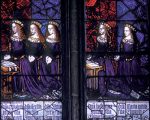
King Edward IV married the Lancastrian widow Elizabeth Wydeville [Woodville] in the spring or summer of 1464. In nineteen years of marriage, Elizabeth gave birth to ten children, seven of whom were daughters. The eldest daughter Elizabeth, born in 1466, remains the most well known in popular and scholarly circles and Edward IV’s other four daughters are significantly neglected both in factual and fictional accounts of their lives. The emphasis on Elizabeth and the neglect of her sisters are perhaps understandable, in that Elizabeth married Henry Tudor in 1485 and gave birth to Henry VIII in 1491. A queen of England undoubtedly attracts more attention than a countess or viscountess. Yet the lives of Elizabeth of York’s younger sisters are interesting in shedding light on the marriage policies of the houses of York and Tudor in an era of intermittent dynastic and political conflict. They also illuminate the contrasting fortunes of members of a side-lined royal dynasty.
[Read More...]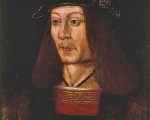
12th March:
1537 – Execution of William Haydock, Cistercian monk. He was hanged for his involvement in the Pilgrimage of Grace. Interestingly, his remains were discovered in the family’s home, Cottam Hall, in the early 19th century because his nephew had saved his body and hidden it there.
1539 – Thomas Boleyn, Earl of Wiltshire and Earl of Ormond, and father of Queen Anne Boleyn, died at Hever Castle, aged around sixty-two. He was laid to rest at St Peter’s Church, Hever.
1564 – Baptism of Christopher Bales, Roman Catholic priest and martyr. Bales was executed by hanging on 4th March 1590 in Fleet Street. Two others, Nicholas Horner and Alexander Blake, were executed at Smithfield and Grays Inn Lane for harbouring him.
1573 (11th or 12th) – Death of Edmund Brydges, 2nd Baron Chandos, soldier, politician, Lord Lieutenant of Gloucestershire and Vice-Admiral of Gloucestershire. He was laid to rest at Sudeley.
1628 – Death of John Bull, composer, musician and organ builder, at Antwerp.
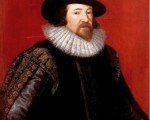
22 January:
1528 – Henry VIII and Francis I declared war on Charles V, Holy Roman Emperor.
1552 – Former Lord Protector of England, Edward Seymour, Duke of Somerset, was executed by beheading on Tower Hill in London. He was laid to rest in the Chapel of St Peter ad Vincula at the Tower of London, and records show that he was buried next to Anne Boleyn in the chancel area. Click here to read more.
1554 – Thomas Wyatt the Younger met with fellow conspirators at his home of Allington Castle in Kent to make final plans for their uprising (Wyatt’s Rebellion) against Mary I and her decision to marry Philip of Spain – click here to read more.
1561 – Birth of Francis Bacon, Viscount St Alban, the Elizabethan Lord Chancellor, politician, philosopher, author and scientist, at York House in the Strand, London. Bacon is known as “the Father of the Scientific method” and developed an investigative method, the Baconian method, which he put forward in his book Novum Organum in 1620. Some people (Baconians) believe that Francis Bacon was the true author of William Shakespeare’s plays.
1575 – Death of James Hamilton, 2nd Earl of Arran and Duke of Châtelherault, at Kinneil. Arran was appointed Regent for the infant Mary, Queen of Scots after James V’s death in 1542, but surrendered the regency to Mary’s mother, Mary of Guise in 1554.
1613 – Death of Sir David Williams, Serjeant-at-Law in Elizabeth I’s reign and Puisne Justice of the King’s Bench in James I’s reign, from a fever at Kingston House, Kingston Bagpuize, Berkshire. His body was buried at St John’s Chapel, Brecon, and his entrails were buried at Kingston.
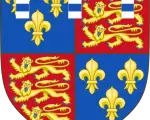
The brief life of Edward Plantagenet, 17th Earl of Warwick, can be interpreted as an exercise in the harsh realpolitik of fifteenth-century England. The only son and heir of George, Duke of Clarence, Edward was born on 25 February 1475 in Warwick; his sister Margaret had been born two years previously. He was the nephew of the first Yorkist king, Edward IV, who had seized the throne from Henry VI in 1461. Edward’s mother Isabel, sister of Richard III’s consort Anne Neville, died when he was an infant, and his father was executed for treason in 1478. The lands of Clarence were seized by the Crown, including those belonging to his infant son. In 1481, Edward was placed in the wardship of Thomas Grey, Marquis of Dorset. He attended the coronation of his uncle Richard in 1483 and was knighted at the investiture of Richard’s heir, also named Edward, at York in September. The prince died the following year and it is possible that the king considered the Earl of Warwick as his heir.
[Read More...]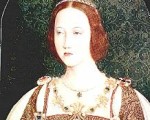
On this day in history…
6th November:
1501 – Catherine of Aragon met Arthur, Prince of Wales, for the first time at Dogmersfield in Hampshire. They married eight days later at St Paul’s.
1514 – Mary Tudor, Queen of France, processed into Paris following her coronation the previous day at Saint-Denis.
1541 – Henry VIII abandoned his Catherine Howard, his fifth wife, at Hampton Court Palace. The investigation into John Lassell’s claims that Catherine had two sexual relationships during her time in the Dowager Duchess of Norfolk’s household had proved them true.
1558 – Baptism of Thomas Kyd, translator and playwright, at St Mary Woolnoth in London. Kyd is known for his play “The Spanish Tragedy”.
1612 – Death of Nicholas Fitzherbert, author and former secretary of Cardinal William Allen, near Florence in Italy. Fitzherbert drowned while trying to ford a stream en route to Rome. Fitzherbert left England in the 1570s because of his Catholic faith and to study law at Bologna. In 1580, while he was in Italy, he was attainted of treason back in England due to his Catholic faith. He was buried at Florence, in the Benedictine abbey.
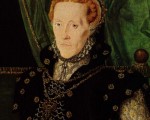
On this day in history…
21st August:
1536 – Death of Robert Sherborn (Sherborne), former Bishop of Chichester, at Chichester. He was buried in the cathedral there. The elderly and conservative bishop was forced to resign his see in June 1536 after being examined by Dr Richard Layton.
1551 – Death of Sir John Packington, judge. He was buried at Hampton Lovett in Worcestershire, where he had settled in 1528. Packington was an active member of the Council of the Marches, a justice for North Wales, Recorder of Worcester, a judge on the Brecon circuit in Wales, and Recorder of Ludlow.
1553 – Death of Sir Thomas Heneage, courtier. Heneage served Henry VIII as Groom of the Stool and Chief Gentleman of the Privy Chamber, and served Edward VI as a Gentleman of the Privy Chamber. He was buried in the chancel of the parish church at Hainton, Lincolnshire.
1568 – Death of Humphrey Llwyd, antiquary, translator and cartographer from a fever. He was buried in the north aisle of St Marcella’s (Llanfarchell) Church, which is also known as Whitchurch or Eglwys Wen. Llwyd is known for producing the first ever printed map of Wales.
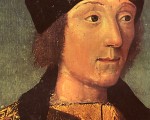
On this day in history, Sunday 7th August 1485, Henry Tudor, son of Lady Margaret Beaufort and the late Edmund Tudor, Earl of Richmond, “came unto Wales”, returning from exile in Brittany to claim the throne of England from Richard III.
Polydore Vergil records Henry’s return:
“Than Henry, thinkinge yt nedefull to make haste, that his arrive the frinds showld not be any longer kept in perplexytie betwene hope and drede, uncertane what to do, after he had made hisprayers to God that he might have an happy and prosperousjourney, he lowsyd from the mowth of Seyne with two thousand onely of armyd men and a few shippes, the calends of August, and with a soft suthren wynde. The weather being very fayre he came unto Wales the 7th day after, a lyttle before soone set, wher, entring thaven caulyd Milford, and furthwith going a land, he took
first a place the name wherof ys Dalley, wher he herd that certane companyes of his adversaryes had had ther stations the wynter by past to have kept him from landing. From thence departing in the breake of dav he went to Haverforde, which vs a towne not xne. myles from Dalley, wher he was receavyd with great goodwill of all men, and the same he dyd with suche celerytie as that he was present and spoken of all at once.”
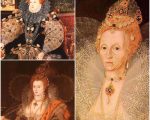
Thank you to Rioghnach for asking this question. Here is her question in full:
“I’m a predominantly Dark Ages re-enactor and I’m frequently in awe of Tudor era female reenactors who tend to have the most amazing lace ruffs and collars. If I use the Armada Portrait of 1588, the Rainbow Portrait of 1600 and Marcus Gheeraerts the Younger’s rather unflattering 1595 portrait of Elizabeth as examples, how were these magnificent lace collars made to remain stiff? I’ve heard tell that Arum italicum and Arum maculatum (aka “Lords and Ladies”) were used to create the starch needed to keep such flamboyant ruffs stiff. Is this true, and if so how was it done?”
Historian Toni Mount, a specialist in the social history of the medieval and Tudor periods, was the perfect person to answer this question, particularly as she had mentioned the use of starch in the Elizabethan period for ruffs in her June 2017 expert talk. Here is Toni’s answer…
[Read More...]
One of my favourite historians, Leanda de Lisle, has just shared details of two talks she’s doing, one at Bosworth Battlefield and one in Yorkshire. Here are the details:
[Read More...]
On this day in history…
13th March:
1540 – Death of Henry Bourchier, 2nd Earl of Essex. He died after falling off a horse, and his title was given to Thomas Cromwell. His daughter, Anne, married Sir William Parr, brother of Queen Catherine Parr.
1543 – Death of Sebastian Giustinian, the Venetian diplomat. He died in Venice at the age of eighty-three. Giustinian served as the Venetian ambassador to England from 1514 to 1519, and wrote 226 letters during his embassy there. He became ambassador to France in 1526 and procurator of St Mark in 1540.
1594 – Death of John Woolton, Bishop of Exeter, from asthma at the bishop’s palace in Exeter. He was buried in the cathedral choir.
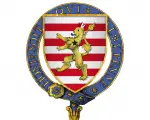
The third article in Sarah Bryson’s series on prominent Tudor courtiers…
In this article, I will be exploring the life of Thomas Brandon, uncle to the more famous Charles Brandon, Duke of Suffolk. Thomas Brandon served five kings during his lifetime; however, it was under the rule of King Henry VIII that he breathed his last. Frustratingly little is known about Thomas Brandon’s early life and most information that we have today comes from his adult years and the latter years of his life serving the Tudor King’s, Henry VII and Henry VIII.
[Read More...]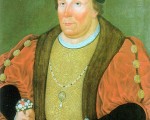
Hello, and welcome to my new series “The King’s Men”. Each month I will be writing an article exploring the life of one man that served Henry VIII. Some of these men had prosperous careers, reaching wondrous heights at court and exerting great influence under the King. Other men reached to high and met their end under orders of Henry VIII. However, each man left their imprint on Henry’s court and history, and it is the lives of these men that I will be exploring each month.
This month I will be looking at the life of Edward Stafford, 3rd Duke of Buckingham.
[Read More...]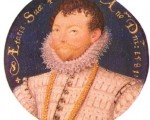
On this day in history, 23rd January…
1516 – Death of Ferdinand II of Aragon in Madrigalejo, Extremadura. He was laid to rest in la Capilla Real, the Royal Chapel of Granada. Ferdinand was the husband of Isabella I of Castile and the father of Catherine of Aragon, Henry VIII’s first wife. Ferdinand was succeeded by his daughter, Juana (Joanna), who ruled jointly with her son, Charles, who became King Charles I of Spain.
1540 – Birth of Thomas Egerton, 1st Viscount Brackley and Lord Chancellor to James I. Egerton was the illegitimate son of Sir Richard Egerton, a landowner from Cheshire, by a servant girl.
1552 – Parliament met to discuss the revision of the 1549 “Book of Common Prayer”.
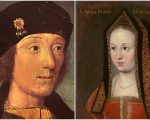
On this day in history, 18th January 1486, the twenty-nine-year-old Henry VII married the twenty-year-old Elizabeth of York.
They made a striking couple. Elizabeth of York had classic English Rose looks – blonde hair, blue eyes and fair skin – and Henry was tall, slim, dark haired and handsome. They were the perfect couple, and their marriage brought hope to the country. It reconciled the warring Houses of Lancaster and York, and began a new royal house and era: the Tudor dynasty.
[Read More...]